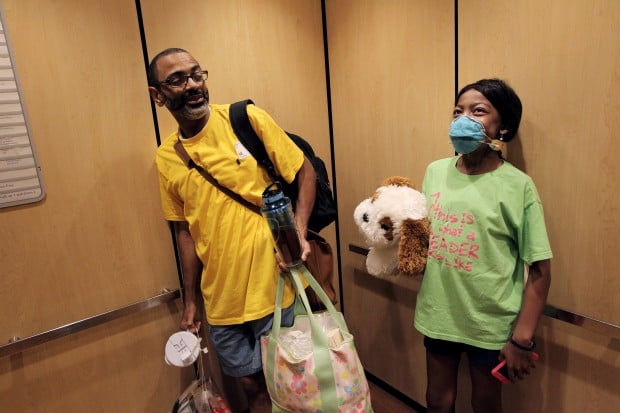After spending three months undergoing and recovering from a risky stem cell transplant, 10-year-old Caitlyn Hill left St. Louis Children’s Hospital last week without any signs of her sickle cell disease.
Caitlyn is only the third person to receive a cord blood transplant from an unrelated donor to treat sickle cell as part of a nationwide study involving Washington University School of Medicine, where researchers are leading the way in finding easier and safer ways to treat non-cancerous diseases with bone marrow and stem cell transplants.
For Caitlyn’s parents, who for months lived with the fear their young daughter could suffer a stroke, the idea that she could no longer suffer symptoms from the inherited blood disorder hasn’t sunk in – even after seeing Caitlyn’s red blood cell counts at levels they had never seen.
People are also reading…
“It’s hard to see beyond to think, ‘Oh my gosh, maybe she’ll never have sickle cell in her life. We haven’t totally grasped that,” said Lena Hill, 38, of Iowa City, Iowa. “We feel really blessed we had Dr. Shenoy to cure our child of the disease.”
Dr. Shalini Shenoy is the director of the hospital’s Pediatric Stem Cell Transplant Program and a pioneer in developing the protocol for transplanting grafts from unrelated donors without using massive amounts of damaging chemotherapy and radiation – opening the door to the rapidly evolving field of using transplants to treat non-cancerous diseases like sickle cell.
“It’s moving the field forward in a way that has not successfully been done before,” Shenoy said.
Bone marrow transplants are typically used as a last-line of defense against cancer, especially leukemia. But in the past 10 years, non-cancerous diseases have gone from making up about 15 percent of all pediatric bone marrow transplants to 35 percent, Shenoy said.
The field emerged in the mid-’90s, when the transplants were found to be successful for patients suffering severe sickle cell disease, but only if their tissue matched a sibling donor.
Transplants from unrelated donors were found to be too toxic – requiring too much chemotherapy and radiation to wipe out a body’s immune system so it won’t reject the donor cells. Efforts to use smaller doses of the chemicals – called “reduced intensity” – resulted in patients’ bodies rejecting the transplants.
Shenoy and researchers at Washington U., however, continued testing the reduced-intensity regimen. “Our approach was different, so we persisted,” she said.
Shenoy’s approach involved using antibodies that target particular proteins in the immune system and finding the amount of toxic chemicals that wipe out just enough of the body’s immunity to allow the graft to take over.
Her approach proved successful in treating sickle cells patients as well as patients with other life-threatening metabolic and bone marrow failure disorders. And about five years ago, it was adopted as the protocol for using transplants from unrelated donors to treat non-cancerous disorders.
But even with expanding the donor pool to unrelated donors, finding a match is difficult. The longer on the waiting list, the more the disease takes its toll. Older children and adults have less successful transplants.
Stem cells from donated umbilical cords can be easier to match. Stem cells are found in bone marrow, the spongy issue inside bone. Stem cell and bone marrow transplants both work the same by replacing a person’s faulty stem cells with healthy ones.
The weak newborn stem cells, however, are more likely to succumb to attack by the body’s immune system. But once again, Shenoy persisted.
“You have better chances of finding a cord match than a marrow,” she said. “It was important for us to find a successful way.”
Adding one more immune-suppression drug to the mix holds promise, winning Shenoy approval to lead a cord-blood transplant study involving about 10 research centers across the country. The study has a safety restriction – three patients must have successful transplant before moving on to the next three. Caitlyn was among the first three cases with sickle cell disease.
For Caitlyn, her only match was cord blood. “That was a little scary. She’s No. 3 in the study ...,” her mother said. “But we trusted Dr. Shenoy, and also, we were scared of what we were seeing with her disease.”
Sickle cell disease is caused by an abnormal protein that damages red blood cells, which carry oxygen to vital organs. The damaged cells, shaped like a sickle, can block blood flow and prevent oxygen and nutrients from reaching organs, including the brain.
Caitlyn suffered a stroke three years ago and another mini-stroke last year. Massive blood infusions to introduce healthy cells weren’t easing her symptoms, and neurological exams showed she was at risk of having another stroke at any time.
Her parents, both English professors at the University of Iowa, began to consider that the risks of a transplant – which include dying from infection while the body’s immune system is down – might be worth taking. Their daughter always has a giant book in her hand and loves jumping on the trampoline. She is an avid writer, singer and actress.
“The idea of having that compromised by a stroke was really scary for us. We felt we were between a rock and hard place,” Lena Hill said. “We felt like we should pray about this, and come to a place where we feel peace about our decision.”
They had some scary moments in the hospital – a mysterious high fever and fluid around her heart – which went away. Tests soon revealed the donor cells had taken over. She had no sickle cells in her blood.
Over the next year, she’ll be monitored closely for signs of her body is rejecting the cells, or vice versa, the cells attacking her body.
“If she makes it through this first year,” Shenoy said, “it’s likely that she is cured.”













